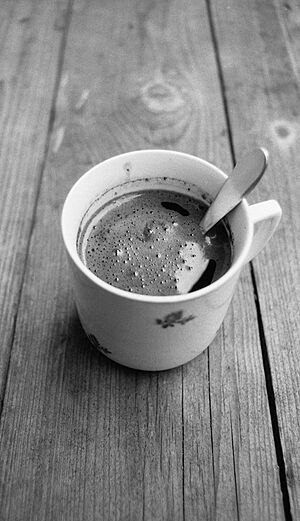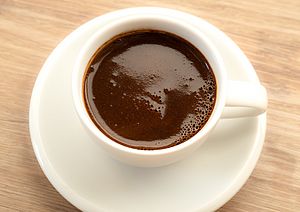Turkish coffee facts for kids

A cup of Turkish coffee, served from a copper cezve
|
|
| Type | Coffee |
|---|---|
| Country of origin | Ottoman Empire |
| Color | Dark brown |
Turkish coffee is a special way to make coffee. It uses very finely ground coffee beans and is brewed without filtering. This means you drink some of the tiny coffee grounds! It's made in a unique pot called a cezve (say: jez-veh).
Contents
How to Make Turkish Coffee
Turkish coffee is made by boiling very finely ground coffee. You can use any type of coffee bean. Many people think Arabica beans are the best. But other types, like Robusta, can also be used.
The coffee grounds stay in the cup when you drink it. You can grind the coffee yourself at home. Some coffee shops will grind it for you. You can also buy it already ground.

To make it, you mix coffee and water in a special pot. This pot is called a cezve in Turkey. In other places, it might be called an ibrik. People often add sugar to the mix.
You heat the pot until the coffee starts to foam. It's important to take it off the heat before it boils over! Sometimes, the coffee is heated two or three times. This helps make more foam.
Traditionally, Turkish coffee is served in a small porcelain cup. This cup is called a kahve fincanı.
Adding Sugar to Your Coffee
When you order Turkish coffee, you choose how much sugar you want.
- It can be unsweetened (Turkish: sade kahve).
- It can have a little or medium sugar (Turkish: orta şekerli).
- Or it can be sweet (Turkish: tatlı).
Turkish coffee is often served with a small, sweet treat. A popular one is Turkish delight. Sometimes, people add flavors like cardamom or mastic to their coffee.
When you pour the coffee, many tiny coffee grounds go into the cup. Some grounds settle at the bottom. But many stay mixed in the coffee. You drink these tiny grounds with the coffee!
History of Turkish Coffee
Turkish coffee likely came to the Ottoman Empire around the 1400s. Traveling merchants probably brought it. A governor named Özdemir Pasha may have shown it to Sultan Suleiman the Magnificent. The Sultan really liked it, and it became very popular.
At one point, some people thought coffee was like a drug. So, drinking it was forbidden. Sultan Murad IV even made it illegal to drink coffee. But because so many people loved it, the ban was eventually lifted.
By the mid-1600s, Turkish coffee culture reached places like Britain and France. The first coffee house in Britain was opened by a person from the Ottoman Empire. In France, the Turkish ambassador held fancy parties. At these parties, guests were served coffee in beautiful cups.
Turkish Coffee Culture
Telling Fortunes with Coffee Grounds
After you drink Turkish coffee, there are grounds left in the cup. Some people use these grounds to tell fortunes! This practice is called tasseography.
To do this, you turn your cup upside down onto its saucer. You let the coffee grounds cool down. Then, you look at the patterns the grounds make. These patterns are then "read" to tell your fortune.
Turkish Weddings and Coffee
Turkish coffee is not just an everyday drink. It's also an important part of traditional Turkish weddings.
Before a marriage, the groom's parents visit the bride's family. They ask for the girl's hand in marriage. During this meeting, the bride-to-be must make and serve Turkish coffee to everyone.
For the groom's coffee, the bride sometimes uses salt instead of sugar! This is a fun way to see how patient and good-tempered the groom is. If he drinks the salty coffee without showing he dislikes it, it means he is calm and patient. It's like a small test for the groom!
Different Names for Turkish Coffee
In some countries that were once part of the Ottoman Empire, people use different names for this coffee. This is often because of national pride.
Armenian Coffee
This strong coffee is very common in Armenian homes. Armenians brought this coffee to the island of Corfu. There, it's called "eastern coffee" because it came from the East.
In the Armenian language, it's called Armenian: հայկական սուրճ, haykakan surč, which means "Armenian coffee." It can also be called սեւ սուրճ, sev surč, meaning "black coffee." This is because it's usually made without milk or cream. If it has no sugar, it's soorj arants shakari. But it's often made with a little sugar. Armenians sometimes serve a plate of baklava with their coffee.
Coffee in Central Europe
In the Czech Republic and Slovakia, a drink called turecká káva or turek is very popular. It's made differently from Turkish coffee in Turkey. They don't use a cezve. Instead, they put ground coffee right into a cup. Then, they pour boiling water over it. This way of making coffee is also common in Poland and Lithuania.
Greek Coffee
In Greece, Turkish coffee used to be called "Turkish" (τούρκικος). But because of political tensions in the 1960s and 1970s, people started calling it "Greek coffee" (ελληνικός καφές). This name became very popular. There were even ads in the 1990s to promote the name "Greek coffee."
Coffee in Former Yugoslavia
In Bosnia and Herzegovina, Turkish coffee is also called "Bosnian coffee" (Bosnian: bosanska kahva). It's made a little differently. When the water boils, a small amount is saved. Then, coffee is added to the pot (called a džezva). The saved water is added back. Everything is heated again for a few seconds. Drinking coffee is a daily tradition in Bosnia. It's important for getting together with friends and family.
In Serbia, Slovenia, North Macedonia, Montenegro, and Croatia, it's called "Turkish coffee" (turska kava / турска кафа). It can also be called "domestic coffee" (domača kava) or simply "coffee" (kava). It's very similar to the Turkish way of making it. In Serbia, it's sometimes called српска кафа (srpska kafa), meaning Serbian coffee. The most common name is домаћа кафа (domaća kafa), which means domestic coffee.
See also
In Spanish: Café turco para niños




